|
Location:
Nasiriya, Iraq |
Grid Reference:
30� 57' 38" N, 46� 6' 18" E. |

 Ur:
(Sumerian Capital).
Ur:
(Sumerian Capital).
Home of the Ziggurat of Ur and the
reputed birthplace of the prophet Abraham.
Ur was the capital of the Sumerian
civilisation and once a great harbour city on the banks of the Euphrates
river, until it changed its course and the city became lost, so that
Wooley was forced to dig vast hole over 40ft deep to uncover the
lowest levels of the city..
(Click here for Map of
site)
|
Ur of the Chaldeans:
('Tall al Muqayyar'): |
Ur
was first found and excavated in 1853 and 1854 by British consul J. E.
Taylor, who uncovered the then sand-covered remains of the famed
ziggurat.
 This city, which is mentioned several times in the Bible as
Ur of the Chaldees (referring
to the Chaldeans, whom settled in the area about 900 BC) as the birthplace of Prophet Abraham "Ibrahim Al-Khalil"
(pbuh), was one of the most important cities of the Sumerians in
the 4th and the 1st half of the 3rd millennium BC. It was also
considered as one of the most active and full of life cities in southern
Mesopotamia during the following centuries. In former days it stood on
the banks of the Euphrates, until the river changed its course. This city, which is mentioned several times in the Bible as
Ur of the Chaldees (referring
to the Chaldeans, whom settled in the area about 900 BC) as the birthplace of Prophet Abraham "Ibrahim Al-Khalil"
(pbuh), was one of the most important cities of the Sumerians in
the 4th and the 1st half of the 3rd millennium BC. It was also
considered as one of the most active and full of life cities in southern
Mesopotamia during the following centuries. In former days it stood on
the banks of the Euphrates, until the river changed its course.
Evidence suggests that
Ur had three classes of people. The richer, government officials,
priests and soldiers, were at the top. The second level was for
merchants, teachers, labourers, farmers and craft-makers. The bottom
were for slaves captured in battle. Burials at Ur give insight into
people's social standing. Kings and queens were buried with treasure as
realised by Wooly's discovery of the 'Royal' burial site. Wealthy people
were buried with less. Since irrigation gave Ur abundant crops, not
everybody needed to work on farms. People learned other skills. Sir
Leonard Wooly made a tablet that listed Ur's special workers. The chisel
workers made sculptures, the gem cutters made gems, and the fuller
stomped on woven wools to make them soft. The metal workers made
weapons. (6)
The use of Bitumen in
construction:
'Baked bricks were used
for the lowest courses of walls, for drains, where bitumen was employed
to make them watertight, and for paved courtyards and other exposed
architecture such as the facades of buildings; important buildings, such
as the ziggurat at Ur, might be encased in baked bricks as a protection
against the elements. The use of bitumen as a mortar, particularly in
the construction of large structures such as city walls, also provided
an effective protection against damp. courses of reed matting and layers
of bitumen were interspersed between those of brick in the construction
of ziggurats to counteract rising damp from the foundations, and
weep-holes also assisted drainage and prevented damp decay. Bitumen was
also employed as a water-proofing material for bathrooms and
constructional timber such as doors. Brick walls were often plastered to
protect them against the rain. Mud could ne used as a plaster but a
stronger and more attractive plaster was made of gypsum or lime, made by
burning limestone.' (7)
(Prehistoric construction techniques)
|
Chronology of Ur.
Ur was an ancient
Sumerian city that was settled in the late sixth millennium,
during the Ubaid period until about 3000 B.C., the area of Ur was
about 37 acres. During the Early Dynastic Period, Ur reached its
maximum area of 124 acres and was one of the richest Sumerian
cities because it was a harbour, and therefore trading, town on
the Persian Gulf. (2)
The earliest occupations at
Ur date to the Ubaid period of the late 6th millennium BC. By
about 3000 BC, Ur covered a total area of 37 acres including
early temple sites. Ur reached its maximum size of 54 acres
during the Early Dynastic Period of the early 3rd millennium,
when Ur was one of the most important capitals of the Sumerian
civilization. Ur continued as a minor capital for Sumer and
succeeding civilizations, but during the 4th century BC, the
Euphrates changed course, and the site was abandoned.
(3)
According to ancient
records, Ur had 3 main dynasties of rulers who at various times,
extended their control over all of Sumeria.
2,670 BC - The founder
of the First Dynasty of Ur was the conqueror and temple builder
Mesanepada , the earliest Mesopotamian ruler described in extant
contemporary documents. His son Aanepadda (reigned about 2650
BC) built the temple of the goddess Ninhursag, which was
excavated in modern times at Tell Al-Obeid, about 8 km north
east of the site of Ur.
2,340 BC - Ur was
captured by King Sargon of Agade, and this era, called the
Akkadian period, marks an important step in the blending of
Sumerian and Semitic cultures. After this dynasty came a long
period of which practically nothing is known except that a 2nd
dynasty rose and fell.
2113 - 2095 BC - Ur-Nammu,
the first king of the 3rd Dynasty of Ur, who revived the empire
of Sumer and Akkad, won control of the outlet to the sea about
2100 BC and made Ur the wealthiest city in Mesopotamia. His
reign marked the beginning of the so-called renaissance of
Sumerian art and literature at Ur. The descendants of Ur-Nammu
continued in power for more than a century, or until shortly
before 2000 BC, when the Elamites captured Ibbi-Sin (reigned
2029-2004 BC), king of Ur, and destroyed the city.
Article:
ABS-CBN News: (13th May 2009)
US returns Ur, birthplace of Abraham, to Iraq.
'UR, Iraq - The US military on
Wednesday handed control of ancient Ur, the biblical birthplace
of Abraham, back to Iraqi authorities, who hope now to re-launch
it as a major tourism site.
"We officially announce the
taking over of Ziggurat of Ur from our friends the Americans,"
Talib Kamil al-Hassan, governor of Dhi Qar province, said at a
ceremony to mark the return of the site six years after the
American invasion.
"We are pleased with this
great success for the nation," he added while the Iraqi flag was
hoisted atop the temple.
"Abraham, peace be upon him,
was born here, the father of prophets and religions," he said.
The site is renowned for its
well preserved stepped platform or ziggurat, which dates back to
the third millennium BC.
It lies near the US air base
of Talila, outside the southern city of Nasiriyah, and has been
closed to the public since the US-led invasion of 2003 that
toppled dictator Saddam Hussein.
Ur of the Chaldees was one of
the great urban centres of the Sumerian civilisation of southern
Iraq and remained an important city until its conquest by
Alexander the Great a few centuries before Christ.
The city, which dates back to
6000 BC, lies on a former course of the Euphrates, one of the
two great rivers of Iraq, and is one of the country's oldest
sites.
The Iraqi Ministry of Tourism
and Antiquities announced in early April that the ceremony would
pave the way for the rehabilitation of Ur and its reopening to
the public.
"The local government will
begin the renovation of the archaeological site in cooperation
with the Ministry of Tourism to be ready to receive tourists
from the region but also across Iraq," said Hassan.
"All Iraqis are proud of this
site and are eager to visit as soon as all the barbed wire has
been removed," he added.
(Link to Full Article) |
The Ziggurat of Ur...
The Great Ziggurat of Ur was a temple of Nanna,
the moon deity in Sumerian mythology, and has two stages constructed from
brick: in the lower stage the bricks are joined together with bitumen, in
the upper stage they are joined with mortar. The temple was built in 2,100
B.C. during the reign of Ur-Nammu and stands 70 feet (21 m) high).
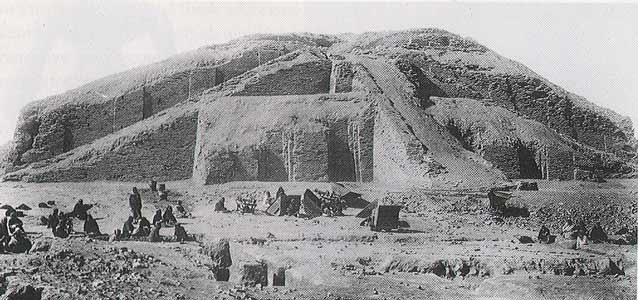
An early image of the Ziggurat from the 1920's.

An image of the building after restoration.

Artistic reconstruction of the original complete structure.
The ziggurat is believed to have been the precursor to the Egyptian
pyramids, which began with the Djosers 1st Dynasty Step-pyramid at
Saqqara.
(More about pyramids)
Excavations :
The city was first excavated in
1853 and 1854 by British consul J. E. Taylor, who uncovered the then
sand-covered remains of the famed ziggurat of Ur which was dedicated to
the moon god Nanna in Sumerian mythology and the Babylonian equivalent
Sin in Babylonian mythology. However, the excavation of the actual city
did not happen until 1918 when the British Museum funded an excavation
under the leadership of British archaeologists Reginald C. Thompson and
H. R. H. Hall. Though excavation ceased in 1919, it was restarted in
1922 in a joint expedition by the British Museum and the University
Museum of the University of Pennsylvania under the direction of British
archaeologist Sir Leonard Woolley. Ending in 1934, this last expedition
was the one that provided the most information on this mighty city of
over 200 000 residents at its peak.
In addition to excavating the ziggurat completely, the
expedition unearthed the entire temple area at Ur and parts of the
residential and commercial quarters of the city. The most spectacular
discovery was that of the Royal Cemetery, dating from about 2600BC and
containing art treasures of gold, silver, bronze, and precious stones.
The findings left little doubt that the deaths of the king and queen of
Ur were followed by the voluntary death of their courtiers and personal
attendants and of the court soldiers and musicians. Within the city
itself were discovered thousands of cuneiform tablets comprising
administrative and literary documents dating from about 2700 to the 4th
century BC. The deepest levels of the city contained traces of a flood,
alleged to be the deluge of Sumerian, Babylonian, and Hebrew legend.
Most of the treasures excavated at Ur are in the
British Museum and the University of Pennsylvania Museum of
Archaeology and Anthropology.
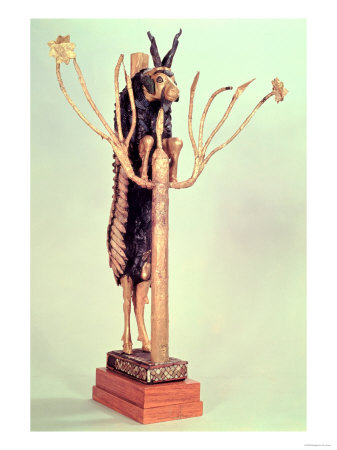
This is one of an
almost identical pair discovered by Leonard Woolley in the 'Great Death
Pit', one of the graves in the Royal Cemetery at Ur. The other is now in
the University of Pennsylvania Museum in Philadelphia. It was named the
'Ram in a Thicket' by the excavator Leonard Woolley, who liked biblical
allusions. In Genesis 22:13, God ordered Abraham to sacrifice his son
Isaac, but at the last moment 'Abraham lifted up his eyes, and looked,
and behold behind him a ram caught in a thicket by his horns: and
Abraham went and took the ram, and offered him up for a burnt offering
in the stead of his son'. (4)
The tube rising from
the goat's shoulders suggests it was used to support something, most
likely a bowl.

Among the estimated 170,000 valuable antiquities that filled Iraq's
Baghdad Museum prior to its tragic looting in April 2003, some of
civilization's oldest musical instruments were proudly exhibited. The
Gold Lyre (replica, right) was one of more than a dozen Sumerian
stringed instruments discovered at the ancient site of Ur in 1927.
The Lament of Ur:
For the
gods have abandoned us
like
migrating birds they have gone
Ur is
destroyed, bitter is its lament
The
country's blood now fills its holes like hot bronze in a mould
Bodies
dissolve like fat in the sun. Our temple is destroyed
Smoke
lies on our city like a shroud.
blood
flows as the river does
the
lamenting of men and women
sadness
abounds
Ur is
no more.
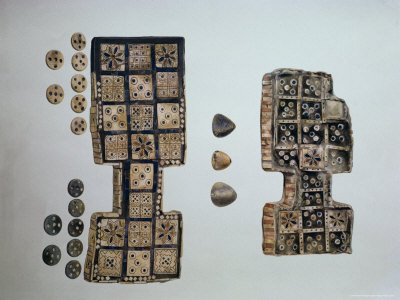
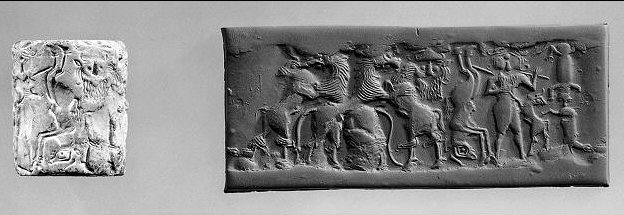
The Indus Valley
seals.
(Genesis. Ch.11) -
'And it came to pass, as they journeyed from the
East, that they found a plain in the land of Shinar, and they dwelt
there'...
Archaeologists can use
both the trade in seals themselves, as well as the distances
between seals and the corresponding sealings, to trace
long-distance trade networks. One such set of seals were
manufactured around 1,900 B.C. on two important island
trading cities in the Persian Gulf - Bahrein and Failaka.
These seals were traded all over the Middle East, and have
been found at diverse and distant locations such as Susa in
Iran, Bactria in Afghanistan, Ur in Iraq, and Lothal on the
west coast of India. By 1,750 B.C. Common Style seals are
found in locations ranging from Spain, to Mycenaean Greece,
to Marlik near the shores of the Caspian Sea. These seals
were made from faience, a less expensive material, and used
by smaller merchants.
(5)
The
first objects unearthed from Harappa and
Mohenjo-Daro were small
stone seals inscribed with elegant depictions of animals,
including unicorn-like figures, and marked with Indus script
writing which still baffles scholars. These seals are dated
back to 2,500 B. C. Source: North Park University, Chicago,
Illinois.
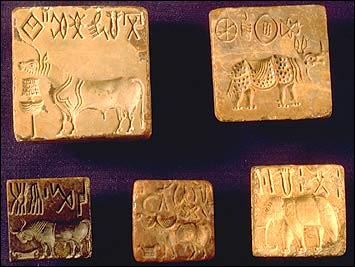 The
first cylinder seals belonged to the now long dead
civilization of the Sumerians, the inhabitants of Nippur,
Lagash, and other cities on the Euphrates and Tigris rivers
in what is now Iraq. They spoke a strange language --
neither Semitic nor Indo-European, the family of languages
spoken by many later civilizations and the most current
inhabitants of the Middle East. Sumerian was an tongue,
bearing resemblance to such diverse languages as Turkish,
Finnish, Japanese, and Dravidian. Indeed, it was probably
some version of the latter tongue that was spoken by their
neighbours, the early inhabitants of the Indus river valley.
These Indus valley people developed, soon after the
Sumerians, their own civilization and unique style of seals.
Modern speakers of Dravidian languages are scattered all
over the Indian subcontinent, including remnants in
Afghanistan and a large number of Tamils in southern India.
Seal impressions have been
found in the ancient city of Harrapan, in the Indus River
valley (modern Pakistan), that had been made by seals found
in Lagash in Sumeria (modern Iraq). From 3,600 B.C. in Sumer,
and a little later in the Indus Valley, we can find seals
made out of a rare high-quality stone, lapis lazuli. These
stones could only have originated from rather distant and
inaccessible mines in Afghanistan.
(More about
Mohenjo Dharo and the Indus Valley Civilisation IVC)
|
Gilgamesh: From Europe to the
Indus Valley.
It was long suspected that there was a connection between the
early dynastic Egyptians and the Sumerians. The Knife found at the Royal
cemetery in Abydoss (right), with its depiction of Gilgamesh, is proof enough,
but the following information suggests that this prehistoric cultural link may
have been stronger than once thought.
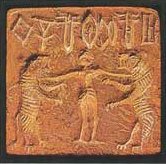
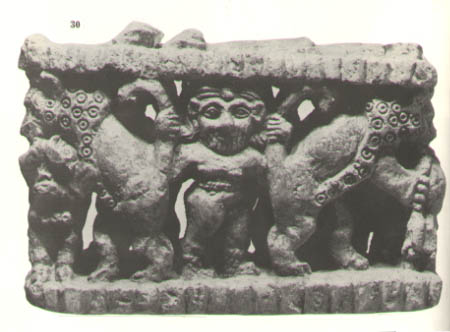

Gilgamesh in
Mohenjo Daro, Indus Valley (left),
Sumeria (centre) and Abydoss, Egypt
(right).
The 'Gilgamesh' figure is an iconic Sumerian
image, found in other prehistoric civilisations such as Early Dynastic Egypt and
the Indus Valley. The same image with a central figure, but with felines flanking a 'female' and not a male figure can be traced back
through other prehistoric locations such as the Mycenaean,
Anatolian and Maltese civilisations.
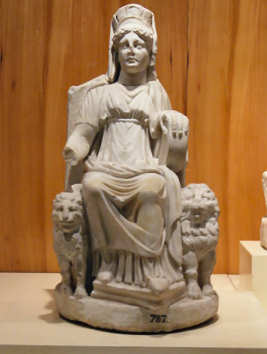
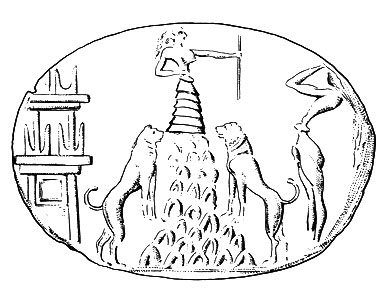

If we go back further into Anatolian prehistory to
Catal hoyuk (8,000 B.C.), for example, we can
also compare the figurine of a large female sitting upon a throne flanked by
either Lions or leopards (right). The Prehistoric European Earth Goddess or
Cybele (left), is also often depicted enthroned with lions as was the
Minoan mountain goddess (centre).
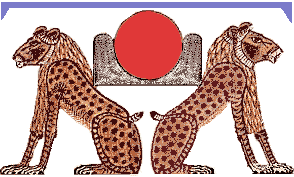
It is interesting to note, in relation to the prehistoric images of
an Earth-Mother-Goddess with Lions on either side, that the Egyptians used the
symbol of two lions 'Aker' to represent the horizon. In this context, we can see
through these earlier iconic images of a female Earth-Mother-Goddess flanked by
felines, a depiction of the literal Earth itself.
(More about Earth Mother Goddess)
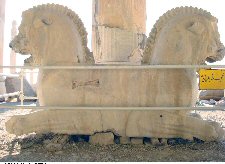


The same symbols were later used as 'guardians' of important cities, temples
etc.
(From left to right - Persepolis, Alaya Huyuk,
Mycenae - flanking the 'world-pillar')
(Cross-cultural similarities between Sumeria and
Egypt)
|
(Other Sumerian
Sites)
|
|

 This city, which is mentioned several times in the Bible as
Ur of the Chaldees (referring
to the Chaldeans, whom settled in the area about 900 BC) as the birthplace of Prophet Abraham "Ibrahim Al-Khalil"
(pbuh), was one of the most important cities of the Sumerians in
the 4th and the 1st half of the 3rd millennium BC. It was also
considered as one of the most active and full of life cities in southern
Mesopotamia during the following centuries. In former days it stood on
the banks of the Euphrates, until the river changed its course.
This city, which is mentioned several times in the Bible as
Ur of the Chaldees (referring
to the Chaldeans, whom settled in the area about 900 BC) as the birthplace of Prophet Abraham "Ibrahim Al-Khalil"
(pbuh), was one of the most important cities of the Sumerians in
the 4th and the 1st half of the 3rd millennium BC. It was also
considered as one of the most active and full of life cities in southern
Mesopotamia during the following centuries. In former days it stood on
the banks of the Euphrates, until the river changed its course.
















